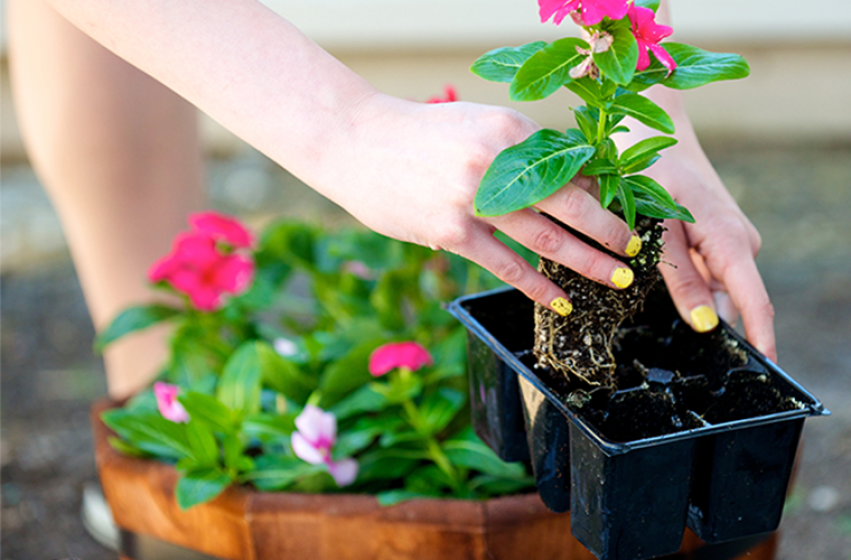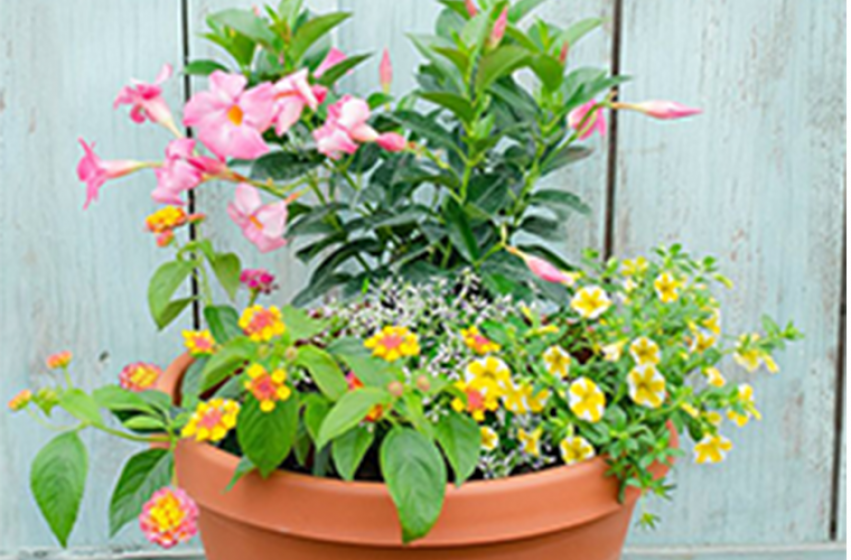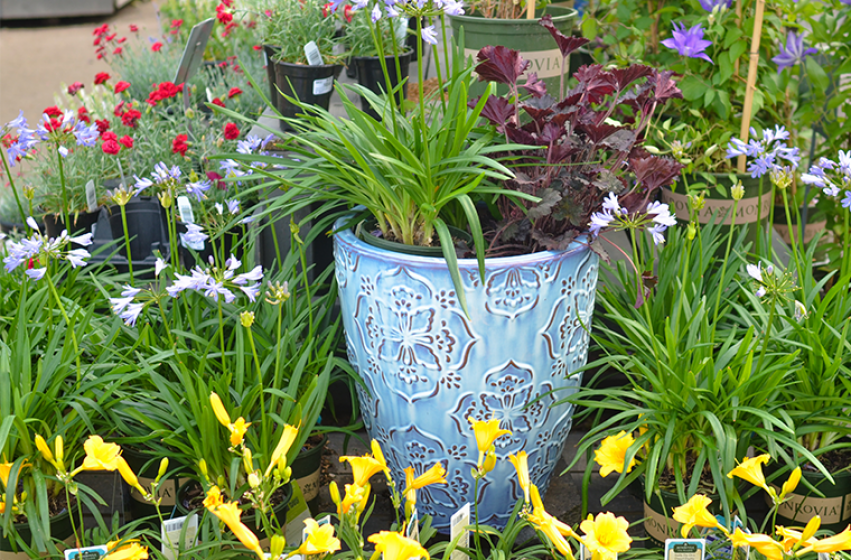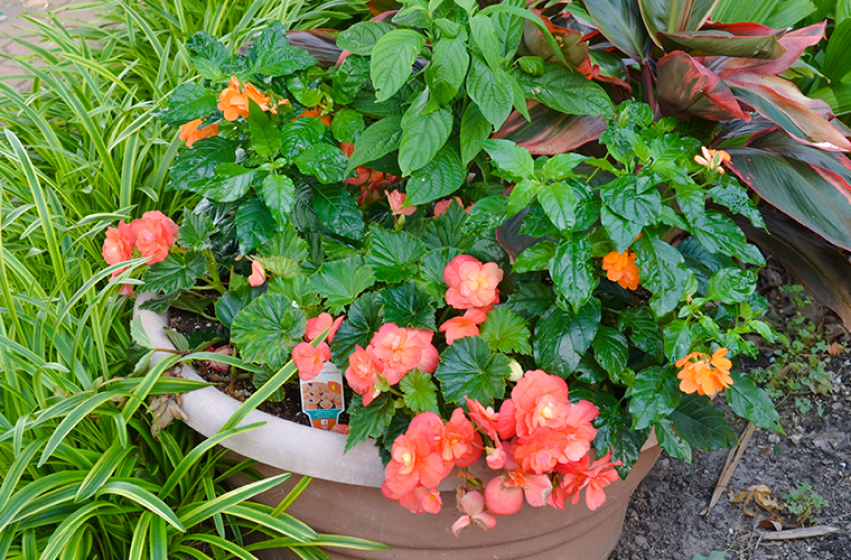If you’re not convinced about growing in containers, we're here to persuade you otherwise. No matter what your gardening challenge, it's very possible that container gardening is the answer. Bad soil? Limited space? Small yard? No yard? No worries! You can grow just about anything in a container – veggies, herbs, annuals, dwarf evergreens, perennials, succulents, and more. Not only will containers add color, they can also provide a focal point in the garden, or tie in the architecture of the house to the landscape. A pair of matching containers on either side of the front walk serves as a warm welcome to guests, while containers on a deck or patio can add ambience and a punch of color to outdoor gathering areas. Whether you want to grow tomatoes, enhance a porch or patio, or attract hummingbirds to your deck, all can be easily accomplished with a little container gardening know-how. Follow these simple steps to make your very own container:
PICK YOUR POT
Pots and containers come in a multitude of sizes, shapes, and colors. Choose one that fits your style and space. Select from terra cotta, ceramic, stone, wood, cement, metal, or plastic. Be aware, however, that porous material such as terra cotta will dry out a little faster. Also, check to see that your container has a good drainage hole, since insufficient drainage can cause plant roots to drown. If your container doesn’t have a drain hole, drill your own or line the bottom of the container with several inches of small rocks.
TIP: Window boxes are ideal for those living in an apartment or those who have a balcony. These can provide the space necessary to grow plants, flowers, or herbs even in the smallest of spaces.
PICK YOUR SOIL
Invest in your soil from the start to encourage a healthy environment for your container plants. A quality potting soil helps plants retain moisture, provides enough air for growing roots to breathe, and supports your plants by providing anchorage for the roots. It’s important to use a potting soil in containers. Other soils are heavier and thicker and can clog the drain holes causing plant roots to drown. Some potting mixes also contain granules of dry, slow-release fertilizer, which is an added bonus. McDonald organic or traditional all-purpose potting soils are formulated specifically for Hampton Roads and are ideal for use in containers.
PICK YOUR PLANTS
Choose plants that go together not only by color but also those that need the same growing conditions. Annual packs are one of the easiest ways to add color and are available in both sun and shade-loving varieties.
- Sun to part sun plants need six to eight hours of direct sunlight each day. Choose from dianthus, verbena, petunias, marigolds, begonias, salvia, celosia, portulaca, and zinnias.
- Shade to part shade plants require less than four hours of direct sun. They should also be placed in an area that is protected from the hot, afternoon sun. Choose from coleus, impatiens, dusty miller, and polka dot plants.
TIP: Use hanging baskets for a quick and easy way to fill a container for instant enjoyment.
PLANT YOUR CONTAINER
- To get started, fill your container with enough soil so the base of the plant (where the stem sprouts from the soil’s surface) is about one inch from the top of the pot- this will make it easier for you to water later. If your potting soil doesn't contain fertilizer, sprinkle a handful over the soil and mix in.
- Next, carefully remove plants from the container by gently squeezing around the sides to loosen the root ball enough to slide out.
- Loosen plant roots slightly and gently place in the fertilized soil mix.
- Once all your plants have been arranged, fill in around plants with potting soil. Lightly pack the soil around the plants to help prevent air pockets and to help establish a good root to soil connection.
- Once you’ve planted your container, water it thoroughly. This will hydrate your plants and firm the soil around the roots.
FERTILIZE REGULARLY
Rapidly growing plants need plenty of nutrients, and container plantings need more frequent fertilizing, since nutrients run through the drainage hole in the bottom of the pot when watered. Fertilize containers every two to three weeks with a granular or liquid fertilizer. McDonald Greenleaf fertilizers are developed specifically for plants in Hampton Roads and are a great, general all-purpose fertilizer. Greenleaf releases nutrients slowly, keeping container plants healthy and strong. In fact, it’s what we use to fertilize our plants.
WATER WISELY
Follow these watering guidelines to ensure your plants stay hydrated and healthy all season long:
- Water in the morning.
- Water roots not the leaves.
- Water deep and less often.
- Water less in cooler temps.
- If your plants and flowers look wilted during the hottest time of the day, it doesn't always mean they need watering. As long as the top of the soil is moist, you probably don’t need to water. Wilting is a self-protective mechanism to prevent too much moisture loss from the root area. Wait and see if the plants perk up after the sun goes down.
TIP: Does my container need watering? Do the finger test - Insert your finger down into the soil. If the soil is dry from the tip of your finger to your first knuckle, it’s time to water.
KEEP THEM LOOKING THEIR BEST
Keep your container plants looking their best throughout the growing season by pruning leggy stems back and removing damaged foliage. Deadheading flowers will help your plants stay disease free and will also encourage new flowers to form. Cut back plants if they get too wild in order to keep the desired shape and form.
CONTAINER IDEAS TO GET STARTED
You will be amazed by just how much you can grow in containers! With a little creativity and imagination, you can create a container garden for your specific interest or simply to add color. Here are a few ideas for container gardens.
Pizza Garden Container – A pizza garden consists of herbs and vegetables used to make pizza. It’s a great way to show kids where food comes from and how it can be used to make delicious meals. Use tomatoes, peppers, onions, spinach, garlic, oregano. parsley, basil, and cilantro.
Mosquito Repellant Container – Why not make a container that not only looks great, but deters mosquitos naturally? Use marigolds, lemongrass, mint, and citronella geranium.
Tea Garden Container – Served hot or cold, herbal teas are a delicious way to experience the refreshing flavor of herbs that can be grown in your very own garden. Use lavender, mint, lemon balm, lemon verbena, ginger, thyme, and chamomile.
Cocktail Garden Container – Create and plant your own cocktail garden to ensure a fresh supply of ingredients for all your favorite cocktail creations. Use mint, basil, lavender, sage, and rosemary.




